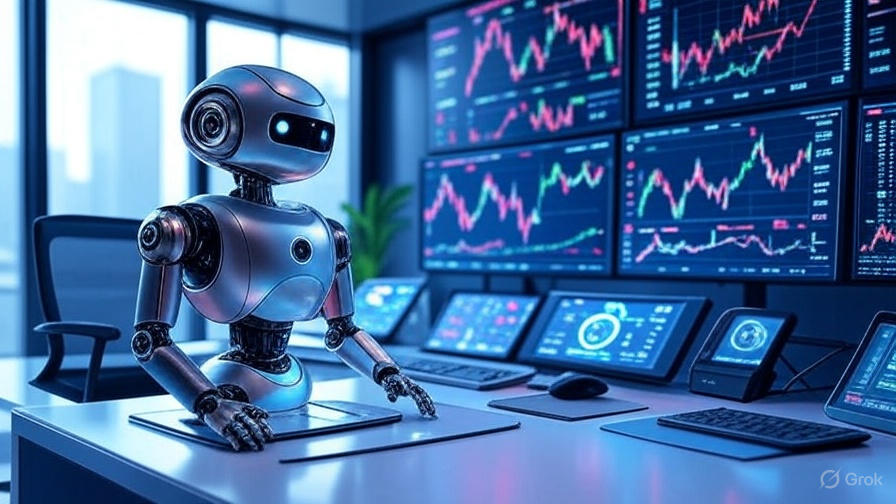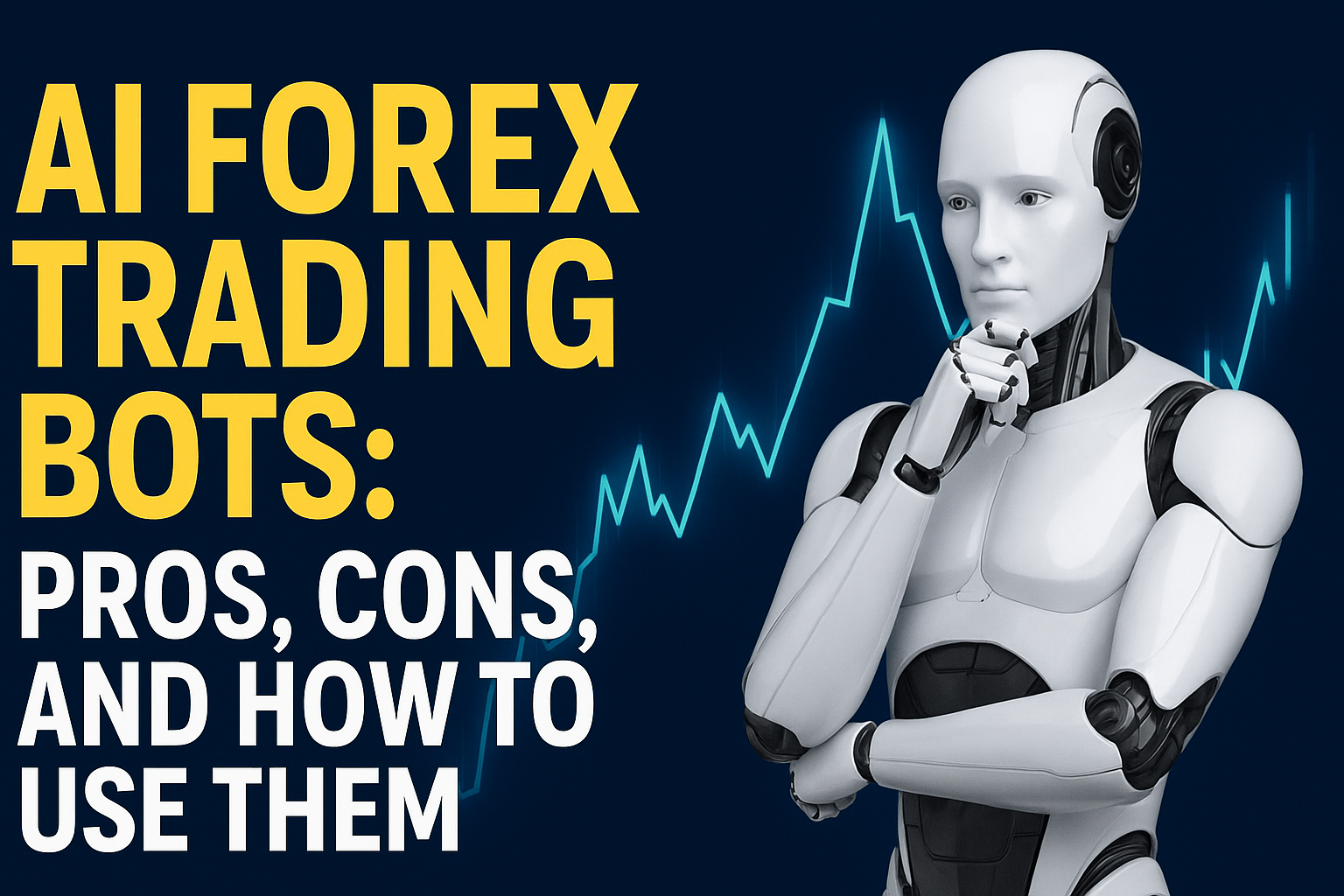Introduction
The forex market is absolutely massive. It’s actually the biggest financial market in the world, with more than $7.5 trillion being traded every single day. For a long time, traders had to do everything themselves—reading charts, keeping an eye on news, and trying to make judgment calls in the middle of the chaos.
But lately, there’s been this whole new thing that keeps popping up everywhere: AI trading bots. These little programs are supposed to trade on your behalf, without needing sleep, without panic, and without that greedy “let me hold this a bit longer” voice in your head. On paper, it sounds almost too good to be true. And maybe it is, maybe it isn’t. Some people swear by them, others say it’s just hype that’s going to fizzle out eventually. The truth is probably somewhere in the middle.
That’s what I want to get into.
What Are AI Forex Trading Bots?
So, let’s keep it simple. A forex trading bot is just a piece of software that analyzes the market and then places trades automatically. The older ones—people call them Expert Advisors (EAs)—are rule-based. Like, “if this indicator crosses that one, then buy.” It’s very much a script, nothing more.
AI bots, though, try to go further. Instead of being locked into the same rigid rules, they use machine learning. Which means they look at massive amounts of data, learn patterns, and then adapt to new situations. Some of the really advanced ones even pull in things like financial news headlines or the general mood on social media.
Here’s an example: say a central bank makes a surprise announcement. A normal EA wouldn’t know what to do unless someone had programmed that exact rule into it. An AI bot, on the other hand, might pick up on the way that currency pair usually reacts to those announcements and adjust its trading automatically.
How Do AI Forex Bots Work?
If you strip it down, the process isn’t as mysterious as it sounds. It usually goes something like this:
First, the bot collects a ton of data. This includes price history, technical indicators, and economic reports, and sometimes even things like Twitter chatter. For instance, it might look back at ten years of EUR/USD price moves after U.S. jobs data came out, just to see what usually happens.
Then, it does the “learning” part. Using AI models like neural networks, it looks for patterns. Stuff that a human trader probably wouldn’t notice. It builds sort of a mental map of, “if this happens, then that’s likely to follow.”
Finally, once it sees a setup it recognizes, the bot places the trade instantly. It connects to platforms like MT4, MT5, or cTrader, and it executes before a human could even move their mouse.
So yeah, in plain English: grab data → analyze it → make a call → hit the trade button.
Why Traders Use Them
The biggest reason is obvious: forex runs 24 hours a day, five days a week. You can’t be awake all the time. Bots can.
Another reason is emotions. Humans get nervous, greedy, impatient—you name it. Bots don’t care. They just follow the data they’re trained on.
And let’s not forget speed. A bot can scan thousands of little data points in seconds. You’d probably miss half of that even if you stared at charts all day.
They’re also great for testing. You can run them on decades of past market data to see if the strategy would have worked. And on top of that, a single bot can keep an eye on multiple pairs at once, which is impossible for any one person.
The Downsides of AI Forex Trading Bots
Now, before you think it’s all sunshine and easy profits, there are some big caveats here.
First off, AI bots aren’t magic. Just because something worked in the past doesn’t mean it’ll keep working in the future. Markets change. Unexpected events happen. Sometimes the bot’s predictions just won’t line up with reality.
There’s also the problem of overfitting. That’s when a bot learns the historical data too well, almost like it memorized it. It looks great in testing but then completely fails when real market conditions shift even slightly.
And let’s be real—technology breaks. Internet drops, servers lag, code glitches out. If you’re not watching, your bot might do something really dumb, like open way too many positions at once or ignore a major event.
On top of that, some bots being sold online are just scams. There are shady vendors who slap the “AI” label on an old EA, market it as the next big thing, and then sell it to people who don’t know the difference. You’ve got to be careful with what you trust.

Types of AI Forex Trading Bots
Not all trading bots are the same, and honestly, they don’t all try to do the same job. Some are built to react to headlines, some are just chasing long-term trends, and others are firing off dozens of tiny trades in seconds. Here are a few of the main ones you’ll run into:
News Sentiment Bots
You’ve got news sentiment bots, which basically try to read the mood. They’ll scan through economic reports or even dig into stuff people post on Twitter or Reddit to figure out if the market is leaning bullish or bearish.
Trend-Following Bots
Then there are trend-following bots. These ones are a bit more patient. Instead of reacting to every little tick, they’re looking at the bigger picture, spotting momentum, and trying to ride it out for as long as it lasts.
Scalping Bots
On the other end, you’ve got scalping bots. These guys are restless. They make a ton of tiny trades, sometimes holding positions for just a few seconds, aiming to grab small profits over and over.
Arbitrage Bots
There are also arbitrage bots, which sound fancy but really just look for price differences between brokers. If EUR/USD is slightly cheaper on one platform than another, the bot buys in one place and sells in the other, pocketing the gap.
Copy Trading Bots
And then, there are copy trading bots. Instead of figuring out the market themselves, they just use AI to mimic what successful traders are already doing. Think of it like following someone else’s homework—if they win, you win, though it’s not always that simple.
How to Choose the Right AI Forex Trading Bot
Here’s the tricky part: not every bot you see online is worth your time. In fact, a lot of them are total garbage. So, how do you even decide which one to trust?
The first thing I always look at is transparency. Does the company or developer actually explain how the bot works? Or is it one of those mysterious “black box” things where you’re just supposed to believe it’ll make money? If they’re hiding everything, that’s usually a red flag.
Next is results, but not just screenshots. Anyone can Photoshop a profit curve. Look for third-party verified performance, like accounts tracked on Myfxbook. That way you know the numbers weren’t just made up for marketing.
You’ll also want to check broker compatibility. Some bots only work on specific platforms or brokers. Imagine buying a bot and then realizing it doesn’t even run on your account—it happens more often than you’d think.
Another good sign is if they offer a trial or demo period. The legit providers are usually confident enough to let you test things out before you go live with real money. If someone insists you pay upfront and gives you no way to try it safely, walk away.
And finally, regulation and compliance. I know, boring stuff, but it matters. There are shady vendors who’ll sell you a bot while promising “guaranteed profits.” That’s nonsense. Nothing in trading is guaranteed, and anyone who says otherwise is just trying to get into your wallet.
Best Practices for Using AI Forex Bots Safely
Even if you find a bot that seems solid, you’ve got to handle it the right way. The biggest mistake people make is thinking they can just plug one in and let it run while they sit back and collect money. That’s not how it works.
Start small. Always, always begin with a demo account or, at the very least, tiny position sizes. That way you see how the bot behaves in real conditions without blowing up your balance.
Be careful with leverage too. Bots can magnify profits, sure, but they can also magnify losses just as quickly. A single bad move with high leverage can wipe you out.
Set up stop-losses and take-profits. Even if the bot is supposed to manage risk, don’t assume it’ll protect you in every situation. Have your own safety nets.
The Future of AI in Forex Trading
It’s pretty clear AI is going to play a bigger and bigger role in trading. Right now, bots are still mostly about data crunching and automation, but the next wave could be a lot more advanced.
We’re already seeing experiments with real-time news analysis, where bots can scan central bank speeches or headlines the second they’re published and react instantly. That’s way faster than any human can read and process.
There’s also the whole big data angle. Imagine bots combining market prices with massive datasets—social media sentiment, global economic reports, even tick-by-tick price feeds. The idea is that AI could spot connections we’d never even think to look for.
And then there’s the wild card: quantum computing. It’s not mainstream yet, but if it ever takes off, it could make today’s AI bots look like calculators compared to supercomputers. The processing speed could mean near-instant analysis and predictions.
Of course, with all this comes regulation. Governments don’t usually like fast-moving tech disrupting financial markets without oversight. Chances are we’ll see stricter rules for AI trading down the road, especially to protect retail traders from getting burned.
So yeah, AI bots aren’t just staying where they are. They’re evolving into more sophisticated assistants that could actually work alongside traders rather than just replacing them.
And don’t disappear once the bot is running. Keep an eye on it. Even the best bots glitch out, or markets move in ways the bot just wasn’t built to handle. Checking in regularly saves you from nasty surprises.
Finally, remember this: bots are tools, not magic replacements for trading skills. Use them alongside your own knowledge and instincts. A hybrid approach—bot plus human judgment—usually works out way better than leaving everything to automation.
Conclusion
AI forex trading bots can definitely be useful. They take a lot of the heavy lifting off your shoulders, they don’t get emotional the way people do, and they can open the door to strategies you might not have the time or brainpower to run on your own. But here’s the thing—they’re not some magic money machine. Bots come with their own risks: they can overfit to past data, they can get tripped up when markets suddenly shift, and let’s be honest, there are plenty of scams out there selling junk as “AI.”
If you’re the kind of trader who’s willing to actually learn how they work, test them properly, and manage risk, then yeah, they can be a solid tool in your trading setup. Just don’t fall into the trap of thinking a bot will do all the work for you. At the end of the day, profits in forex still come down to discipline, risk control, and knowing what you’re doing. The bot is there to help—but it’s not going to save you from bad habits.
